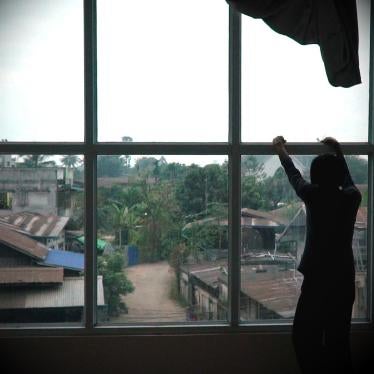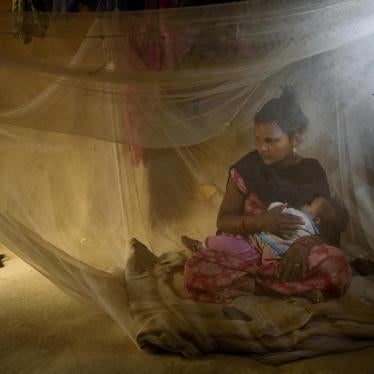- サウジアラビアの国境警備隊は、2022年3月~2023年6月にイエメン-サウジアラビア国境を越えようとした少なくとも数百人のエチオピア人移民や庇護希望者を殺害した。
- サウジアラビア当局者はスポーツウォッシングに何十億ドルも費やし、自国のイメージアップを図る一方で、世界の目が届かないところで何百人もの女性や子どもたちを殺害している。
- サウジアラビアは、移民や庇護希望者に対して殺傷力を行使する政策を即刻かつ緊急に廃止すべきだ。関係国はアカウンタビリティ(説明責任)を追及し、国連は調査を実施すべきである。
(ロンドン)サウジアラビアの国境警備隊は、2022年3月~2023年6月にかけてイエメンとサウジアラビアの国境を越えようとした少なくとも数百人のエチオピア人移民や庇護希望者を殺害したと、ヒューマン・ライツ・ウォッチは本日発表した報告書で述べた。移民を殺害するというサウジアラビア政府の政策の一環でなされたのであれば、これらの殺害事案(現在も続いていると思われる)は人道に対する罪に該当することになるだろう。
今回発表の報告書「『雨のような銃撃だった』:サウジアラビアによるイエメン-サウジアラビア国境でのエチオピア人移民の大量殺害」(全73頁)の明らかにしたところによると、サウジ国境警備隊は、爆発性武器を使用して多くの移民を殺害したほか、移民(多くの女性や子供を含む)を至近距離から射殺している。これらは広範に行われている組織的な攻撃の一環だ。サウジ国境警備隊が移民にどの手足を撃ってほしいかと尋ね、それから至近距離で発砲したケースもある。サウジ国境警備隊はまた、イエメンに逃げ帰ろうとする移民に爆発性武器を発砲している。
「サウジアラビア当局は、世界の目が届かないこのような辺境の国境地帯で何百人もの移民や庇護希望者を殺害している」と、ヒューマン・ライツ・ウォッチの難民・移民の権利リサーチャーのナディア・ハードマンは述べた。「サウジアラビアは何十億ドルも費やして、プロゴルフトーナメントを誘致し、サッカークラブを買収し、主要なエンターテイメントイベントを開催することで、自国のイメージアップを図っているが、こうした忌むべき犯罪行為から目をそらすようなことがあってはならない」。
ヒューマン・ライツ・ウォッチは、2022年3月~2023年6月にイエメン-サウジアラビア国境を越えようとしたエチオピア人移民や庇護希望者38人、およびその期間に越境を試みた人の親族や友人4人の計42人にインタビューを行った。ヒューマン・ライツ・ウォッチは、ソーシャルメディアに投稿されたものや、他の情報源から収集した350本以上の動画と写真、数百平方キロメートルの衛星画像を分析した。
ヒューマン・ライツ・ウォッチは、サウジ当局とフーシ当局に書簡を送った。フーシ当局からは2023年8月19日に返信があった。
サウジアラビアには約75万人のエチオピア人が住み、働いている。多くは経済的な理由で移住しているが、最近の北部での残虐な武力紛争を含め、エチオピアでの深刻な人権侵害行為を理由に逃れてきた者も少なくない。
ヒューマン・ライツ・ウォッチはイエメン-サウジアラビア国境での移民殺害事例を2014年から記録してきたが、今回の殺害は殺害の人数も方法も意図的にエスカレートされているようだ。
移民や庇護希望者は、航行には適さない船でアデン湾を渡ると、イエメン人の密入国ブローカーから、サウジアラビアと国境を接し、武装集団「フーシ」が現在支配するサアダ県まで連れて行かれたという。
インタビューを受けた人の多くが、フーシの部隊はブローカーとぐるになって、自分たちを恐喝したり、「出場料」を払えるまで虐待にさらされる、移民たちが「収容所」と呼ぶ場所に移送したりすると話している。
移民たちは最大200人ほどのグループを作り、国境を越えてサウジアラビア側に何度も入ろうとするが、サウジ国境警備隊に阻まれるため幾度となく越境を試みることなる。移民たちによると、グループには男性よりも女性が多く、同伴者のいない子どももいたという。ヒューマン・ライツ・ウォッチは、こうした証言と符合するサウジ国境警備隊の警備所を衛星写真から特定した。ヒューマン・ライツ・ウォッチはまた、耐地雷・伏撃防護車両(MRAP)と見られる車両を、2021年10月10日~2022年12月31日にかけて、サウジ国境警備隊の警備所の1つで確認した。この車両は屋根の砲塔に重機関銃を搭載しているようだった。
集団で移動していた人びとは、国境を越えるとすぐにサウジ国境警備隊の方向から迫撃砲など爆発性武器で攻撃されたという。インタビューからはサウジ国境警備隊が爆発性武器を使用した事案が28件述べられた。生存者たちは、サウジアラビアによって収容施設に拘束されることもあったと話す。その期間は数ヵ月に及ぶケースもあった。
インタビューを受けたすべての人びとがおぞましい光景を詳しく証言した。女性、男性、子どもの身体が、重傷を負ったり、すでに死んでいたり、バラバラになった状態で山がちの土地に散乱しているのだ。「最初は一緒に食事をしていた人が、次第に死んでいった」と、ある人は述べた。「ばらばらになった遺体が四散していて誰だか判別できないこともあった。真っ二つになっていた人もいた」。
ヒューマン・ライツ・ウォッチのデジタル調査では、ソーシャルメディアに投稿された動画や、ヒューマン・ライツ・ウォッチに直接送られてきた動画を検証し、位置を特定することで、小道や収容所、医療施設で死傷した移民の姿を確認した。地理空間分析からは、移民収容所付近に埋葬地が増えており、国境警備インフラが拡大していることが明らかになった。
著名な法医学専門家からなる国際拷問被害者リハビリテーション協議会(International Rehabilitation Council for Torture Victims)の独立法医学専門家グループ(Independent Forensic Expert Group)のメンバーは、死傷した移民を撮影した検証済みの動画や写真を分析し、損傷の原因を調べた。その結論によれば、「熱と破片を発生させる能力をもつ弾薬の爆発と一致する明確なパターン」を示す損傷のほか、「銃創と一致する特徴」を持つ損傷や、「火傷がはっきりわかる」一例もあった。
小さなグループを作るか、自分たちだけで移動した人びとは、イエメン-サウジアラビア国境を越えるとすぐ、ライフル銃を持ったサウジ国境警備隊に銃撃されたと話す。また、警備兵から岩や金属棒で殴打されたという。インタビュー対象者のうち14人が、至近距離での銃撃事件を目撃するか、自分自身も銃撃で負傷していた。うち6人は、爆発性武器による攻撃と銃撃の両方の標的にされた。
サウジ国境警備隊が国境警備所から外に出てきて生存者を殴ったという証言もあった。ある17歳の男性は、国境警備隊が、他の生存者をレイプすることを拒んだ移民を処刑した後、自分と他の生存者たちに2人の少女をレイプするよう強要したと語った。
サウジアラビアは、明示的か事実上かを問わず、移民や庇護希望者に対し、爆発性武器や至近距離からの銃撃で狙うなどして殺傷力を行使する政策を即時かつ緊急に廃止すべきだ。同国政府は、イエメン国境での不法な殺害、負傷、拷問に責任のある治安要員を調査し、適切なかたちでの懲戒または訴追の対象とすべきである。
関係国政府は、サウジアラビアに対しこうした政策の廃止を公に要求し、アカウンタビリティ(説明責任)を求めるべきだ。暫定的な措置として、関係国政府は国境で続いている人権侵害行為への関与が確信できるサウジアラビアとフーシの当局者に制裁を科すべきである。
移民への人権侵害行為とともに、殺害が人道に対する罪に該当するかどうかを評価するために国連の支援する調査を設置すべきである。
「サウジ国境警備隊は、非武装の文民に発砲していることを実際に知っていたか、知っていなければならなかった」と前出のハードマンは述べた。「エチオピアからの移民や庇護希望者に対する重大犯罪と見られる行為に法による裁きがなされなければ、殺害と人権侵害行為はいっそう深刻化することは間違いない」。


.jpg?itok=NCJ5q9UG)








